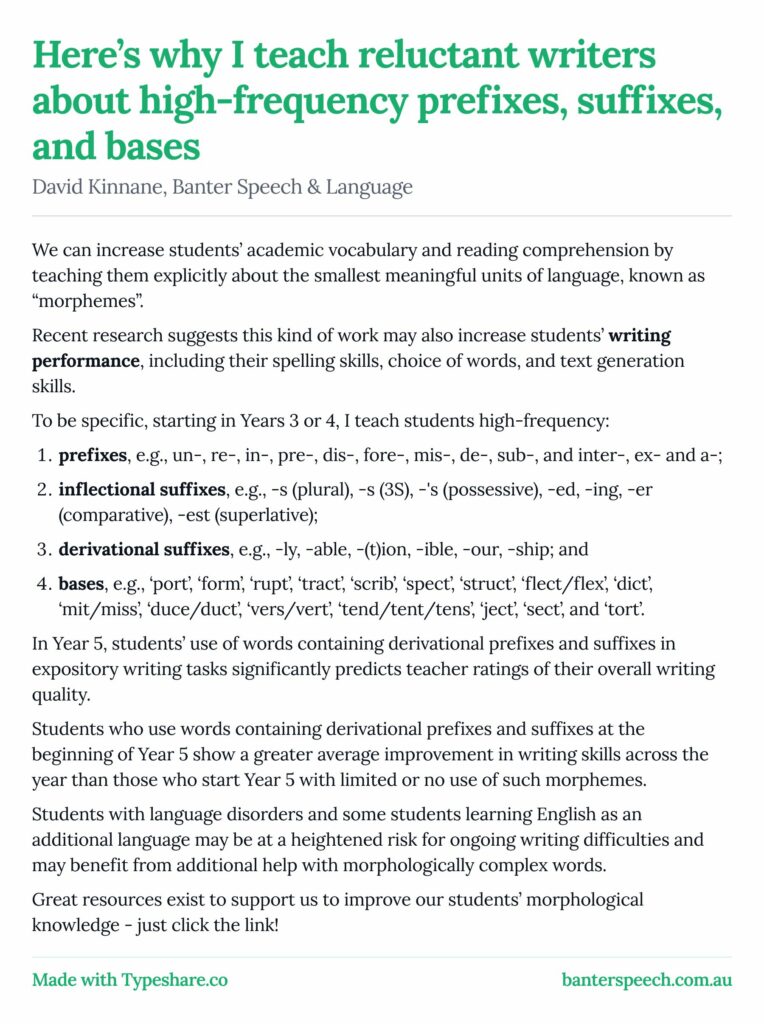Why I teach reluctant writers about high-frequency prefixes, suffixes and bases
With thanks to Wood, Garcia-Salas, Schatschneider, and Torres-Chavarro (2024), here’s why I teach reluctant writers about high-frequency prefixes, suffixes, and bases:
We can increase students’ academic vocabulary and reading comprehension by teaching them explicitly about the smallest meaningful units of language, known as “morphemes”.
Recent research suggests this kind of work may also increase students’ writing performance, including their spelling skills, choice of words, and text generation skills.
To be specific, starting in Years 3 or 4, I teach students high-frequency:
- prefixes, e.g., un-, re-, in-, pre-, dis-, fore-, mis-, de-, sub-, and inter-, ex- and a-;
- inflectional suffixes, e.g., -s (plural), -s (3S), -‘s (possessive), -ed, -ing, -er (comparative), -est (superlative);
- derivational suffixes, e.g., -ly, -able, -(t)ion, -ible, -our, -ship; and
- bases, e.g., ‘port’, ‘form’, ‘rupt’, ‘tract’, ‘scrib’, ‘spect’, ‘struct’, ‘flect/flex’, ‘dict’, ‘mit/miss’, ‘duce/duct’, ‘vers/vert’, ‘tend/tent/tens’, ‘ject’, ‘sect’, and ‘tort’.
In Year 5, students’ use of words containing derivational prefixes and suffixes in expository writing tasks significantly predicts teacher ratings of their overall writing quality.
Students who use words containing derivational prefixes and suffixes at the beginning of Year 5 show a greater average improvement in writing skills across the year than those who start Year 5 with limited or no use of such morphemes.
Students with language disorders and some students learning English as an additional language may be at heightened risk for ongoing writing difficulties and may benefit from additional help with morphologically complex words.
Great resources exist to support us to improve our students’ morphological knowledge – see below!
Wood, C. Garcia-Salas, M., Schatsneider, C., Torres-Chavarro, M. (2024). Morphological Complexity in Writing: Implications for Writing Quality and Patterns of Change, American Journal of Speech-Language Pathology, 33, 1432-1442.

This article also appears in a recent issue of Banter Booster, our weekly round up of the best speech pathology ideas and practice tips for busy speech pathologists, providers, speech pathology students, teachers and other interested readers.
Sign up to receive Banter Booster in your inbox each week:
Free morphology resources:
Morphology Instruction – Literacy Through Language
The Root Repository – Jason Wade Education
Greek Morphology and Etymology in PhOrMeS
Morpheme matrices | ATLAS Hamline University
30 Morphology Resources – Dr Kelly J. Grillo
Science Root Words – Fabio Di Salvo
Related resources:
High Frequency Prefixes and Suffixes in Context Mega-Bundle

Hi there, I’m David Kinnane.
Principal Speech Pathologist, Banter Speech & Language
Our talented team of certified practising speech pathologists provide unhurried, personalised and evidence-based speech pathology care to children and adults in the Inner West of Sydney and beyond, both in our clinic and via telehealth.








